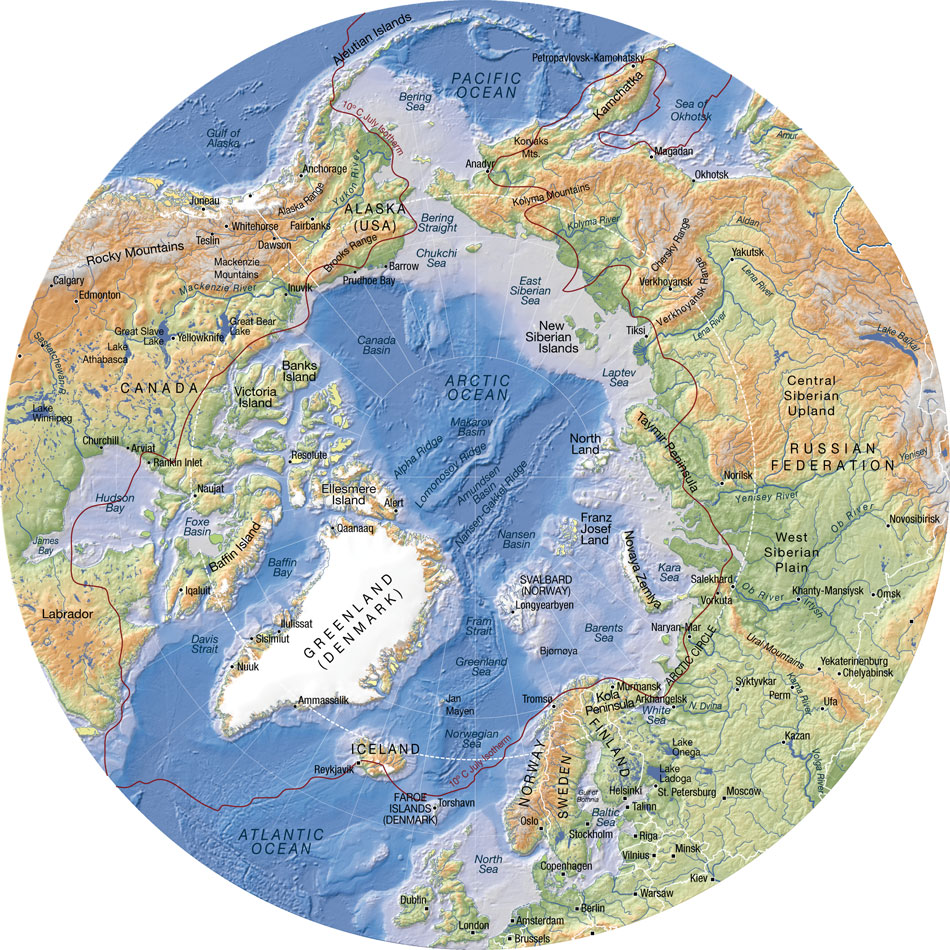Climate Change, Natural Resources, and Geopolitics in the Arctic
In August of 2007, a Russian mini-submarine dived through the ice to the ocean floor beneath the North Pole and planted a Russian flag, in support of its claim that the ocean off its northern coast was part of its territorial waters. Denmark and Canada have since made similar claims.
Under international law, the five countries surrounding the North Pole (Russia, Canada, Norway, the United States, and Denmark through its dependent territory Greenland), are limited to exclusive economic zones (EEZ) of 200 nautical miles (230 miles) adjacent to their coasts. Russia and Canada are lodging applications to extend the limit further based upon claims that parts of the Arctic are extensions of their own continents. Interests in the Arctic have also been expressed by Finland, Iceland, and Sweden within the Arctic Circle, plus some other European states, as well as China, India, and South Korea.
The motive behind this maneuvering is to secure positions of access to the Arctic’s resources and new sea lanes. The Arctic has warmed roughly twice as fast as the global average, as light and heat reflecting snow and ice are replaced by darker-colored, heat-absorbing land and water. Sea ice has been shrinking, and projections indicate that Arctic summers will be ice-free in the 2030s.
Due to this warming, resources including diamonds, zinc, gold, nickel, and iron are drawing countries to the Arctic. Fish will also be sought there as traditional fishing waters are depleted. And climate change will make parts of the Arctic suitable for agriculture. Oil and gas figure most prominently among sought-after resources as demand for energy increases while current sources are depleting. The U.S. Geological Survey estimates that 13 percent of the world’s undiscovered oil and 30 percent of its untapped natural gas lies in the Arctic. The vast majority of the Arctic’s oil and gas is within the EEZs of surrounding countries, and 70 percent of the natural gas is attributed to Russia; smaller amounts are expected to be found in unclaimed areas.
However, costs of extraction and transportation of oil and gas will remain high, and environmental risks are considerable. Ice-free times of year will be limited, and recovery from accidental spills will be extremely difficult and costly. Furthermore, the current boom in unconventional oil and gas production in warmer climates makes Arctic oil and gas less competitive. Nonetheless, exploration has already begun.
The quest for new navigation routes is competitive as well. The long-sought Northwest Passage to connect the Atlantic and Pacific Oceans through the Canadian Arctic Archipelago is claimed by Canada as its internal waters. It, and the Northeast Passage along the northern coast of Russia, would reduce the distance from Europe to Asia by about a third. These faster routes have not gone unnoticed by the militaries of Russia and the U.S. in particular. Russia, Canada, and the U.S. have existing military bases in the Arctic.
Some four million people live in the Arctic. Many belong to indigenous tribes that have lived there for millennia. While this expected activity may be an economic boon for them, drilling and mining present risks of environmental degradation, as well as altering their traditional ways of life.
Climate change negotiations will resume in Paris in December 2015, (see previous blogpost “Paris 2015 UN Climate Change Conference,” October 24, 2014) with a goal of completing a universal agreement. The future of the Arctic region, like all parts and peoples of the planet, will be impacted by that agreement.

